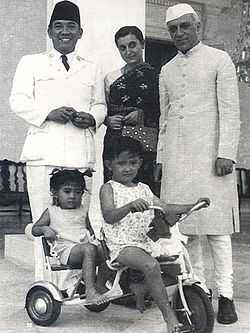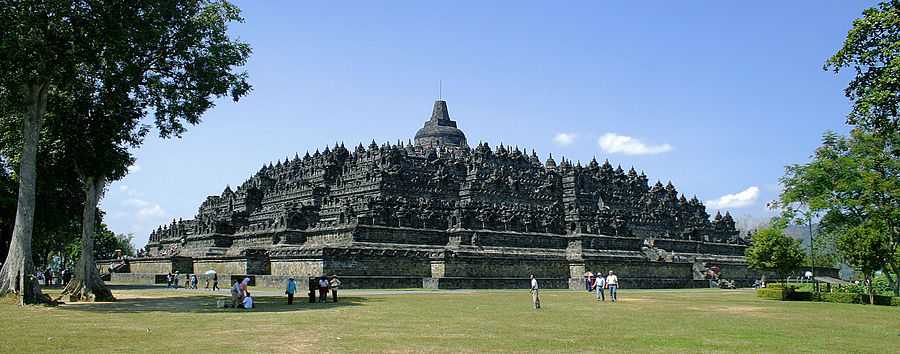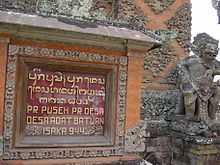India–Indonesia relations
 |
|
India |
Indonesia |
|---|---|




Indian-Indonesian relations refers to the bilateral relations of India and Indonesia. India and Indonesia are neighbours. India's Andaman and Nicobar Islands share a maritime border with Indonesia along the Andaman Sea.
The Indian-Indonesian relationship stretch back for almost two millennia. In 1950, the first President of Indonesia - Sukarno called upon the peoples of Indonesia and India to "intensify the cordial relations" that had existed between the two countries "for more than 1000 years" before they had been "disrupted" by colonial powers.[5] Yet in the spring of 1966, the foreign ministers of both countries began speaking again of an era of friendly relations.
India has an embassy in Jakarta [6] and Indonesia operates an embassy in Delhi.[7] India regards Indonesia as a key member of ASEAN. Both nations had agreed to establish a strategic partnership.[8] The two countries have significant bilateral trade.[9]
Indonesia and India are member states of the G-20, the E7 (countries), the Non-aligned Movement, and the United Nations.
According to a 2013 BBC World Service Poll, 51% of Indonesians view India's influence positively, with 21% expressing a negative view, one of the most favourable perceptions of India in the world.[10]
History
The ties between Indonesia and India date back to the times of the Ramayana,[11] "Yawadvipa" (Java) is mentioned in India's earliest epic, the Ramayana. Sugriva, the chief of Rama's army dispatched his men to Yawadvipa, the island of Java, in search of Sita.[12] Indians had visited Indonesia since ancient times, and ancient Indonesian (Austronesian people) has embarked in maritime trade in Southeast Asian seas and Indian Ocean. The Ancient Indians spread Hinduism and many other aspects of Indian culture including the Sanskrit and Brahmi Script. The trace of Indian influences is most evident in great numbers of Sanskrit loanwords in Indonesian languages.
The name Indonesia derives from the Latin Indus, meaning "India", and the Greek nesos, meaning "island". (due to the similarity of the culture in both regions).[13] The name dates to the 18th century, far predating the formation of independent Indonesia. During the Srivijaya era, many Indonesians studied at Nalanda University in India.[14]
Indonesia entered its historical period after the adoption of Pallawa script and Sanskrit language from India as evidence in some of earliest inscriptions dated from Indonesia's oldest kingdoms such as the Yupa of Kutai, Tugu of Tarumanagara and historical records of Kalingga. Indianised Hindu-Buddhist kingdoms, such as Srivijaya, Medang, Sunda and Majapahit were the predominant governments in Indonesia, and lasted from 200[15] to the 16th century, with the last remaining being in Bali.
Throughout their shared history, most of relations between ancient India and Indonesia were harmonious and peaceful, however there was one exception when ancient India and Indonesia were involved in warfare against each other. In 1025 Rajendra Chola, the Chola king from Coromandel in South India, launched naval raids on ports of Srivijaya and wrested Kadaram from Srivijaya and occupied it for some time.[16]
The Indian Epics — the Ramayana and the Mahabharata — play an important role in Indonesian culture and history, and are popular amongst Indonesians to this day. In the open theatres of the Prambanan in Java, Javanese Muslims perform the Ramayana dance during full moon nights. An example of deep Hindu-Buddhist influence in Indonesian history is 9th century Borobudur and Prambanan temples. Even after the adoption of Islam, the link between two countries remained strong; not only because India has a significant population of Muslims herself. Indonesian Islamic architecture, especially in Sumatra, has been deeply influenced by Indian Mughal architecture, evident in the Baiturrahman Grand Mosque in Aceh and Medan's Great Mosque.
Cultural admiration is not one-sided however, Indians also relate closely to Indonesian culture.
In 1945—1949, during Indonesian National Revolution and the formation of the republic, India and Egypt were among the earliest nations that supported and recognised Indonesian independence and fostered diplomatic relations with Republic of Indonesia. In addition, prior to Indonesia's independence Muhammad Ali Jinnah - the founder of Pakistan - who at that time was President of the All-India Muslim League, encouraged Indian Muslim soldiers serving in British Indian army to join hands with Indonesians against their fight against the Dutch Empire colonisation of Indonesia. As a result 600-Muslim soldiers of the British Indian Army deserted the colonial forces putting their lot at stake, and allied with Indonesians.[17] India and Indonesia officially opened the diplomatic relations since 3 March 1951.[18] In 1955, Indian Prime Minister Jawaharlal Nehru and Indonesian President Sukarno were among the five founders of the Non-aligned Movement.
During the 1965 war with India, Indonesia offered to provide Pakistan with military help, and 'to seize Andaman and Nicobar Islands' of India so as to distract it from the Kashmir front, eventually mobilising submarines to help Pakistan. A maritime boundary agreement between the two countries was issued in New Delhi on 14 January 1977.[19]
Economic relations
On 25 January 2011, after talks by Indian Prime Minister Manmohan Singh and visiting President of Indonesia Susilo Bambang Yudhoyono, India and Indonesia had signed business deals worth billions of dollars and set an ambitious target of doubling trade over the next five years.[20]
India also has further economic ties with Indonesia through its free trade agreement with ASEAN, of which Indonesia is a member.[21]
President of Indonesia Sukarno was the first chief guest at the annual Republic Day parade of India. In the year 2011 too, President Susilo Bambang Yudhoyono was the chief guest for the same. The two countries target to achieve a bilateral trade of $25 Billion by 2015, with cumulative Indian investments of $20 billion in Indonesia.[9]
Culture
The cultural ties still continue, with popular Indonesian Dangdut music displaying the influence of Hindustani musics. Bollywood films and music are also popular in Indonesia.[22] To promote Indian culture in Indonesia, the Jawaharlal Nehru Indian Cultural Centre was established in Jakarta in 1989, featuring a library and providing lessons on Indian culture, as well as promoting art such as Yoga, Indian music and dance [23]
Culture itself from both the countries share some similarities also, like the word Pribumi which means Indonesian Natives derives from the Sanskrit which Pri means original/native and Bumi means earth/soil, besides that Indonesian and Indian people also have some similar personality which they like to eat with hands, watch Bollywood movies, etc. The Dangdut which is a popular Indonesian music genre is very similar to the classical Hindustani songs/music, which uses the traditional Indian percussion instrument which is the Tabla, and Indonesians while listening to it usually dance to the song, which is similar to Indian traditions. Pasar Baru in the Jakarta area for business districts are popular with the Indian shops and fabric selling, it is also popular in Mayestik market in southern Jakarta which Indians sell the most popular fabric shop which is called Bombay. The popular department store also have Indian names from epics that is the: Ramayana Department Store. Street names also take languages from the Sanskrit which is the Jl. Surya Dharma in the city of Tangerang, etc. Transportation in Jakarta commonly uses the Bajaj which is an Auto Rickshaw from India.
References
- ↑ "Borobudur : A Wonder of Indonesia History". Indonesia Travel. Retrieved 5 April 2012.
- ↑ K.A. Nilakanta Sastri, A History of South India, pp 424–426
- ↑ http://www.omniglot.com/writing/balinese.htm
- ↑ The 'Invention Of Tradition' In Indian Food
- ↑ Foreign Policy of India: Text of Documents 1947-59 (p.54)
- ↑ http://www.embassyofindiajakarta.org/
- ↑ http://www.indonesianembassy.org.in/
- ↑ Getting closer to Indonesia
- ↑ 9.0 9.1 "Indian pushes for early economic accord with Indonesia". IANS. news.biharprabha.com. Retrieved 24 April 2014.
- ↑ 2013 World Service Poll BBC
- ↑ Ramayana to Bollywood, Indonesia Loves India
- ↑ History of Ancient India Kapur, Kamlesh
- ↑ Tomascik, T.; Mah, J.A.; Nontji, A.; Moosa, M.K. (1996). The Ecology of the Indonesian Seas - Part One. Hong Kong: Periplus Editions Ltd. ISBN 962-593-078-7.
- ↑ http://jnicc.com/doc/Ramayana%20to%20films.pdf
- ↑ http://daceband.com/read_blog/20112/indonesia
- ↑ Craig A. Lockard (27 December 2006). Societies, Networks, and Transitions: A Global History. Cengage Learning. p. 367. Retrieved 23 April 2012.
- ↑ Pakistan aims for better relations with Indonesia beyond politics The Jakarta Post, 24 June 2008
- ↑ RI-India Perluas Kerjasama Ekonomi, Energi dan Hukum Antara News
- ↑ "India-Indonesia Maritime Boundary Agreement" (PDF). Foreign Affairs Record. XXIII (1): 2. January 1977. Retrieved 6 August 2013.
- ↑ "India and Indonesia aim to double trade". BBC News. 25 January 2011.
- ↑ "India and Asean aim to boost trade". BBC News. 3 March 2011.
- ↑ Ashwini Devare (16 November 2011). "Neighbourly warmth infuses Indonesia-India relations". IBN Live. Retrieved 16 November 2011.
- ↑ Jakarta's Indian Cultural Centre on the Move
External links
| ||||||||||||||||||||||||||||||||||||||||||||||||||||||||||
| ||||||||||||||||||||||||||||||||||||||||||||||||||||||||||||||||||||||||


